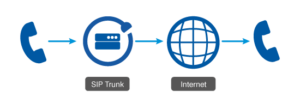 Business SIP
Business SIP
You may have heard the term SIP mentioned before. This article provides an overview of what SIP is all about and what it can do for your business.
SIP is short for Session Initiation Protocol. In very simple terms SIP is a set of rules used to deliver data packets which hold audio. Simplified further, SIP can be described as a modern telephone line. It is also sometimes referred to as VoIP which Voice over Internet Protocol.
Some History
Before I explain why SIP is what your business will be using (if not already), it is important to understand what SIP is replacing. Traditional phone lines is what SIP replaces. Traditional phone lines could be purchased as a single line with a single phone number which was traditionally delivered to you over copper. The traditional phone line is also commonly referred to as a PSTN Line or a POTS service. PSTN stands for Public Switched Telephone Service and POTS stands for Plain Old Telephone Service. These are all one in same, just a phone line.
If you needed more than one phone line you would traditionally buy multiple PSTN Services or you had the option of buying an ISDN Service. ISDN stands for Integrated Services Digital Network. ISDN was capable of delivering you multiple phone lines over a single copper pair. The options were two lines, known as ISDN 2 or 10 lines, known as ISDN 10. Scaling up from there you could also buy ISDN20 and ISDN 30 which were 20 lines or 30 lines respectfully. ISDN is now a discontinued product and can no longer be ordered. This is what SIP is replacing.
So in summary you had the option of purchasing a single line, two lines, ten lines, twenty lines or thirty lines delivered to you over a single pair of copper.
Benefits of SIP
Telecommunications providers have discontinued ISDN and are now delivering SIP as its replacement because SIP offers far more flexibility. You can buy as many SIP Channels are you require. Each SIP channel is effectively a phone line and you are not limited to buying two, ten or more channels. What is even better is the number of channels you need can be increased or decreased as required. SIP is scalable on the fly where ISDN and PSTN is not easily scaled.
The other benefit SIP has is it is feature rich. SIP supports voice, video and instant messaging. SIP will continue to be the communication protocol for business interactions because of the benefits it provides.
Arguably the most important benefit of SIP is the fact that is is not constrained to the physical location to which it is installed. When you purchased and had a PSTN or ISDN service installed, the telecommunications provider would come out and fit a socket to the wall or cable in a box your phone system would plug into. You phone lines existed where these services were terminated.
How is SIP Delivered
SIP is delivered over a data service. That data service does not have to be dedicated to SIP. When you buy a SIP service you are given a username and password. That is all you need to begin making phone calls if you have an active Internet connection that can reach the SIP host to which you have subscribed. There is no copper that needs to be run and no visit required from your telecommunications provider to establish a SIP Service.
Because a SIP Service is not physically constrained, there is nothing stopping you from purchasing a service in another state, territory or country for that matter. When you logon to the SIP Service, any calls you make will originate from the location it was purchased.
Caveat Emptor
While SIP all sounds very straightforward and easy to buy and use, there are are some tricks of the trade that you need to look out for to implement a business grade solution.
- Each SIP Channel needs to have 64 KBps of uncontended bandwidth available.
- Overhead of approximately 23Kbps needs to be added to the calculation.
- The router you are using needs to comfortably be able to “route” at the maximum speed of your data service.
- If you are using a single data service for SIP and Internet Traffic then Quality of Service (QoS) needs to be implemented.
The four points above assume you are looking to implement a business grade solution that is both robust and provides the same voice quality as a traditional phone line. If you do not adhere to the above your phone service will neither be robust nor will the quality of your voice calls be consistent.
Convergence
As SIP is data, the option to converge your services is now possible. Separate voice and data services can operate over a single service. With the maturing of the NBN in Australia, a single Enterprise grade NBN Service can provide dedicated bandwidth for voice (TC-2) and best effort bandwidth for Internet traffic (TC-4). There are cost benefits in running a single service for multiple applications that allows business to reduce costs and increase functionality and efficiencies.
As always, we are here to help. Converging services and integrating them into an existing network can become complex. If you require any advice or assistance please reach out to us.


